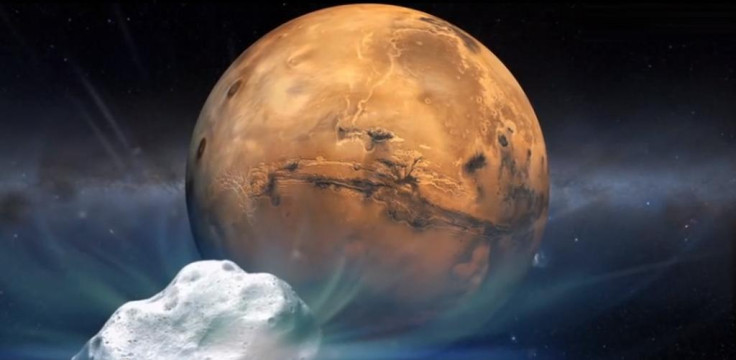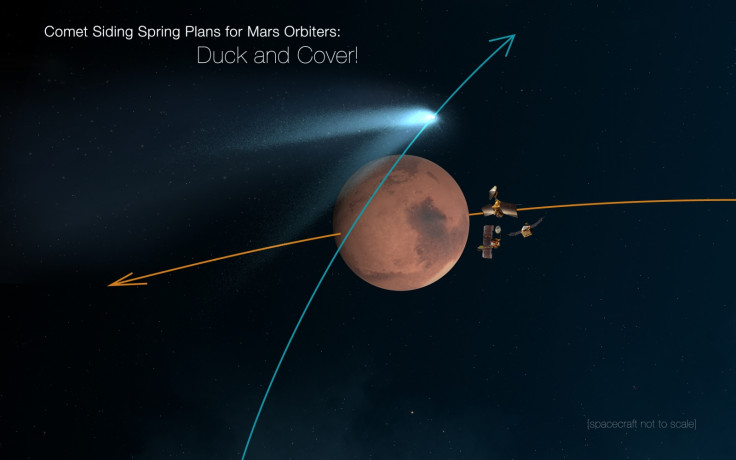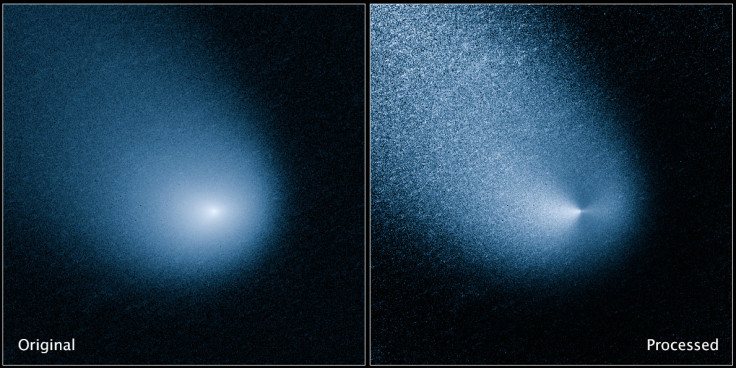Siding Spring: Mars Orbiters Safely Parked and Poised for Ringside View of Comet Flyby

Space agencies of America, Europe and India have shifted their Mars orbiters to the far side of the planet to avoid any risk from the debris field of Comet Siding Spring.
The Comet C/2013 A1, also known as comet Siding Spring, will fly past Mars late on Sunday in one of the closest planetary approach by a comet, giving scientists an invaluable opportunity to learn more about the materials, including water and carbon compounds, that went into the formation of the solar system 4.6 billion years ago.

Passing within about 139,500 km of Mars, it will be at less than half the distance between Earth and our moon from the Red Planet, and less than one-tenth the distance of any known comet flyby of Earth, says Nasa.
Siding Spring's core will be closest to Mars around 2:27 pm EDT (6.27 pm GMT), hurtling at about 56 km per second.
The period of greatest risk to orbiting spacecraft will start about 90 minutes after this and last about 20 minutes, when Mars will come closest to the centre of the widening trail of dust flying from the comet's nucleus.
Siding Spring comes from the Oort Cloud, a spherical region of space surrounding our sun and occupying space at a distance between 5,000 and 100,000 astronomical units. It is composed of a swarm of giant icy objects left over from the formation of the solar system.
Siding Spring is the first comet from the Oort Cloud to be studied up close by spacecraft.

Nasa's three orbiters will gather information before, during and after the flyby about the size, rotation and activity of the comet's nucleus, the variability and gas composition of the coma around the nucleus, and the size and distribution of dust particles in the comet's tail.
India's orbiter MOM will also take shots of the comet before and after the encounter. Indian space scientists hope to get a peek into the composition of the gases in the comet's tail.
Isro expects the earliest pictures to be processed by Monday afternoon while the science data will take longer to interpret.
The comet is near the Sun for the first time and probably started its travel into the solar system nearly 4.6 billion years ago when man first appeared on earth, say experts.
This also means conditions on the comet are unaltered from that time and could give an idea about the materials that went to build the solar system.
"Siding Spring probably got knocked into the inner Solar System by the passage of a star near the Oort Cloud," Carey Lisse, from the Johns Hopkins University Applied Physics Laboratory, explained to BBC.
"So think about a comet that started to travel probably at the dawn of man and it's just now coming in."
The steep angle of its descent to the planetary ecliptic and its speed of more than 50 km per second are what points to its origins from the Oort.
Travelling at that velocity, if the comet strikes an object like a planet, the energy released would be immense.
This is why scientists like University of Maryland's Jessica Sunshine point to the need to be vigilant for these types of comets which tend to announce themselves with only a few months' warning.
Siding was first seen in January 2013.
Nasa manoeuvered its Mars Odyssey orbiter, Mars Reconnaissance Orbiter (MRO), and the latest in its fleet the Mars Atmosphere and Volatile EvolutioN (MAVEN), in order to reduce the risk of impact with high-velocity dust particles coming off the comet.
India's space agency Isro likewise manoeuvred its MOM spacecraft's orbit to ensure it avoids the comet debris.
Koteswara Rao, Isro scientific secretary, told Times of India, "We are planning to use all our scientific payloads to study the comet. At the time of its fly past, MOM will be at a distance of 1.35 lakh kilometre from the comet, thereby avoiding any damage."
Europe's orbiter too is poised for capturing some interesting ringside data on Siding.
The Mars Express will also be looking at Mars' atmosphere during the flyby besides studying the comet's composition and the interaction between the planet, comet and solar wind. The spacecraft will operate under normal conditions and will not be in the safe mode planned earlier.
Initially, the comet and its debris of gas and dust were predicted to pass much closer to Mars, posing a serious risk to the fleet of orbiting spacecraft. Later observations confirmed that the miss distance will, in fact, be more comfortable, says ESA.
© Copyright IBTimes 2025. All rights reserved.





















